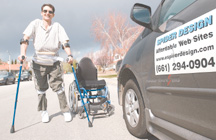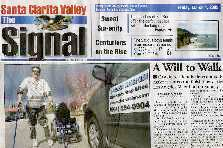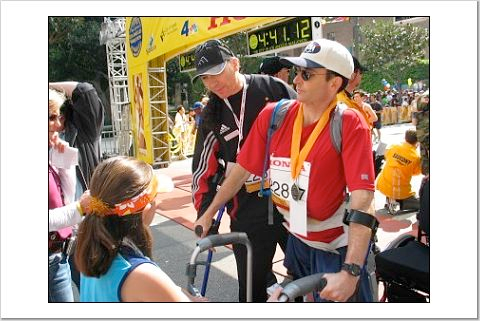A Will to Walk


Marc Richards, 45, of Castaic will participate in Sunday’s Los Angeles Marathon. EDDIE SADIWA/The Signal
3/4/2005
Stephen K. Peeples Signal Staff Writer
Marc Richards is as pumped up about participating in the Los Angeles Marathon on
Sunday as any of the 25,000 others who have signed up.
But the Castaic resident is unlike any other participant
— he’s paralyzed from the chest down.
Richards, 45, is the only paraplegic set to stand up
from his wheelchair and walk across the finish line under his own power, with
some help from leg braces, forearm crutches and extreme will.
“I’ll be walking slightly uphill toward the finish
line at 5th and Flower, so I’ll have to push myself to get across, but
that’s how I want it,” Richards said. “I’ve even bought a new pair of
running shorts. I’m stoked.”
Walking across the marathon finish line is a giant step
in a long-term physical rehabilitation program Richards began two years ago to
get back on his feet after being confined to a bed and a wheelchair for more
than five years.
Richards credits his clinical exercise physiologist,
Taylor-Kevin Isaacs, with starting him down this life-affirming path. Isaacs is
a sports medicine expert who has been working with people with physical
disablities for 14 years. Richards trains with Isaacs each Friday at Gold’s
Gym in Northridge.
“Taylor’s whole concept is exercise
rehabilitation,” Richards said. “He was a professor in kinesiology at Cal
State Northridge for several years, then went into private practice. His goal is
to help people rehabilitate through exercise.”
“It’s important to set goals,” Isaacs said.
“Training is toiling toward a goal, and confidence comes from demonstrated
ability. That’s what Marc and I have been getting by training for the
marathon.”
“The L.A. Marathon has been my goal since last
fall,” Richards said. “I figured out how long I could walk, then how far I
could walk in that time — about 350-400 feet in 30 minutes. Doesn’t seem
like a lot, but it is. So I plan to start walking about 400 feet from the finish
line.”
Isaacs will be at Richards’ side Sunday, but only for
safety, not to hand-hold.
“Marc has become ripped, stripped and fully
equipped,” he said. “He’s a lean, mean, gleaming and shining
vegetable-eating, water-drinking exercise machine.”
Richards has indeed come a long way since he lost use of
his legs.
In January 1998, the then-chief information officer for
Autoland suffered a grand mal seizure. Doctors discovered and removed a
golf-ball sized malignant tumor from his brain.
“I went home three days later and back to work in a
few weeks. At the end of March, I started taking a chemotherapy drug, but
overdosed,” Richards said.
Richards said the overdose was caused by confusion about
the prescribed medication’s dosage. The result was disastrous.
“On May 2, I woke up like any other morning, but my
legs didn’t work,” he said.
His own white blood cells had attacked and damaged his
spinal cord, paralyzing everything below his chest in a condition called
myelitis.
After a six-month stay at UCLA Medical Center and a
short time at Henry Mayo Newhall Memorial Hospital re-learning daily living
activities, Richards went home.
“Since then I’ve learned how to cope with my
disability,” he said — physically, psychologically and emotionally.
He lives with his wife, Nancy, and their son and
daughter, 13-year-old Jacob and 10-year-old Sami.
The family has remodeled their home to be more
user-friendly for Richards and invested in a new minivan with special hand
controls.
Professionally, Richards applied his pre-injury
marketing and computer skills to a new home-based enterprise, Spider Design,
building Web sites for clients including the Castaic Chamber of Commerce and the
Santa Clarita Academy Swim School, where he also exercises. He also built
spinalman.com to chronicle on his own rehab.
“I’m a Type-A personality,” Richards said. “I
couldn’t just sit around and say, ‘Woe is me.’ I’m not supporting myself
with Spider Design yet, but it’s not really about that. My wife works
full-time, and I have SSDI money coming in. The point is, Spider keeps me
excited, talking and working with company presidents and CEOs, like I used
to.”
The most profoundly positive change in Richards’ life
as a paraplegic, however, came when he connected with Isaacs two years ago.
“I knew nothing about standing or walking then —
just wheeled around,” Richards said.
In his initial evaluation, Isaacs saw Richards suffered
from degenerative changes that often accompany a disabling condition and lack of
exercise.
“With exercise, there’s only one way to go —
up,” Isaacs said. “I say, ‘If your butt ain’t moving, your body ain’t
grooving.’ ... When I told Marc he could walk using a reciprocal gait orthosis
(frame) and forearm crutches, his eyes lit up. From that moment, he had the
motivation, and with the education, we were destined for success.”
“We went from me sitting to standing,” Richards
said. “Then in July 2003, I was fitted for long leg braces and learned how to
walk with them. Now, 20 months later, I’m not only putting weight-bearing
pressure on my legs, but I’m also getting the therapeutic exercise of walking.
This alone has been a fantastic source of pain relief and strength-building.
I’m now walking about 30 minutes a day.”
Isaacs said: “He has my eternal respect because he
inspires through his words as well as his actions.”
(897 words)
After this article appeared, this follow up picture appeared in the Signal.
